I’m not saying I have a favorite craft, but if I did, it would be making a witch doll. I love clay, wax and mud dolls the most. Consequently, they’re like poppets on steroids (to me). Moreover, there’s something delightfully primal about sculpting a little figure, naming it, and giving it purpose. As a result, it taps into a very old, very human kind of magic: sympathetic image magic. Essentially, you know the drill, do something to the witchcraft doll, and the magic you conjure and it “becomes” that person. Clearly, it’s easy, eerie, and effective. Can be lovely too, just saying.
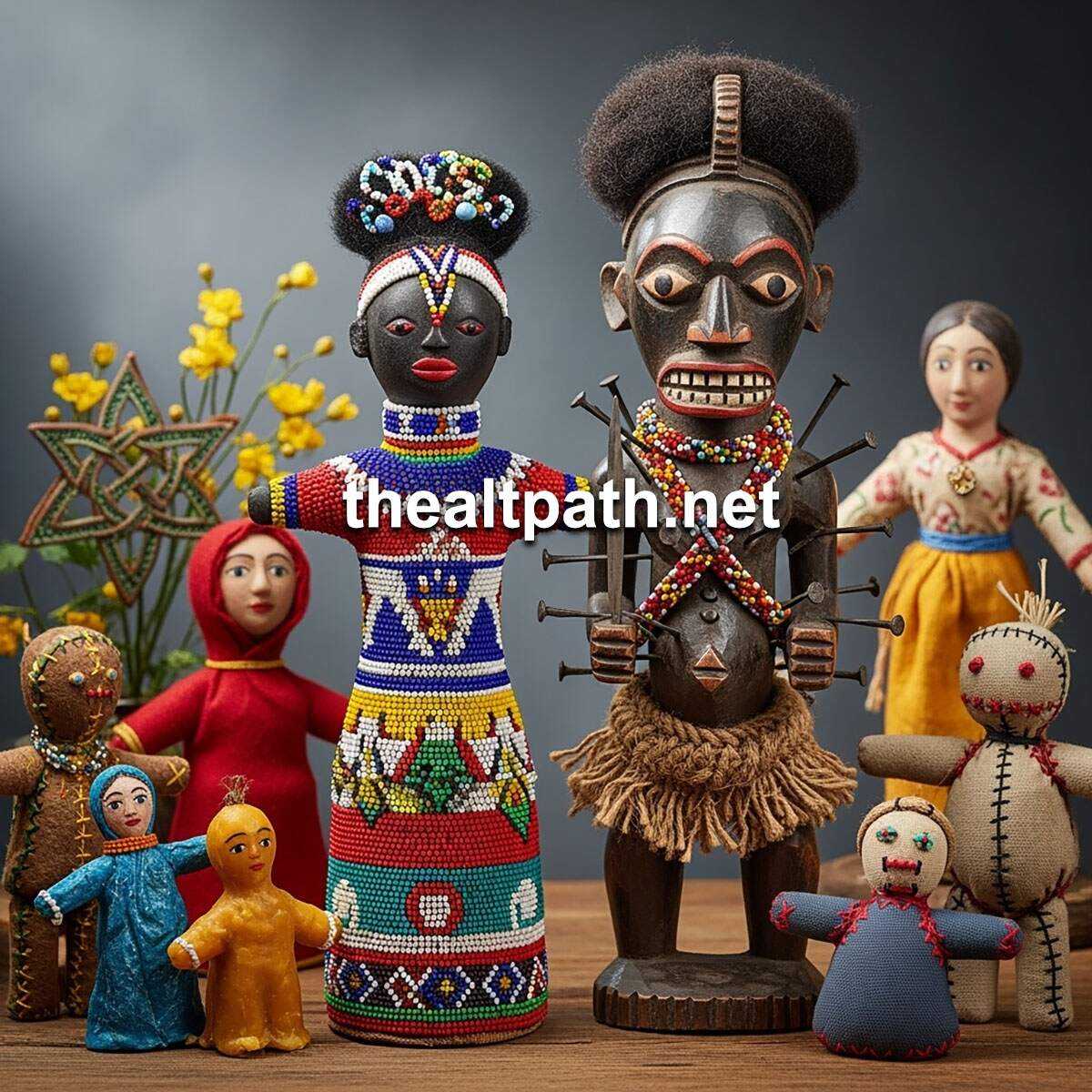
A sample of witch dolls of different cultures
One thing I would like to point out before we totally dive into this: Witchcraft dolls can be used for very positive things like healing, protection and prosperity. Make one of yourself or a loved one for positive things. Witchcraft is art and science, neither good or evil.
I will give you some of my spell-craft tips on clay dolls in this article; Go to clay doll tips. Additionally, look for TIPS in my articles too!
Witch Doll: More than Voodoo Dolls
Now, before we dive into the dark and sticky, let’s set the record straight: the so-called “voodoo doll” you saw in movies? First of all, blame Hollywood. During the U.S. occupation of Haiti in the early 1900s, sensationalist propaganda painted Haitian Vodou as all pins and curses. In contrast, a witch doll is not a core part of Haitian Vodou. Instead, it’s more of a European import, which then got baked into Hoodoo and New Orleans Voodoo (Tann, 82-83).
Admittedly, ancient Egypt? Oh, they were pros at making a witch doll. Specifically, clay and stone figures of enemies got stabbed, decapitated, even stomped under doors. To clarify, Pharaonic spell-work meets home security system. Ultimately, these rituals were all about protecting the state, but the logic was the same: what happens to the image, happens to the target (Ritner, ch. 4).
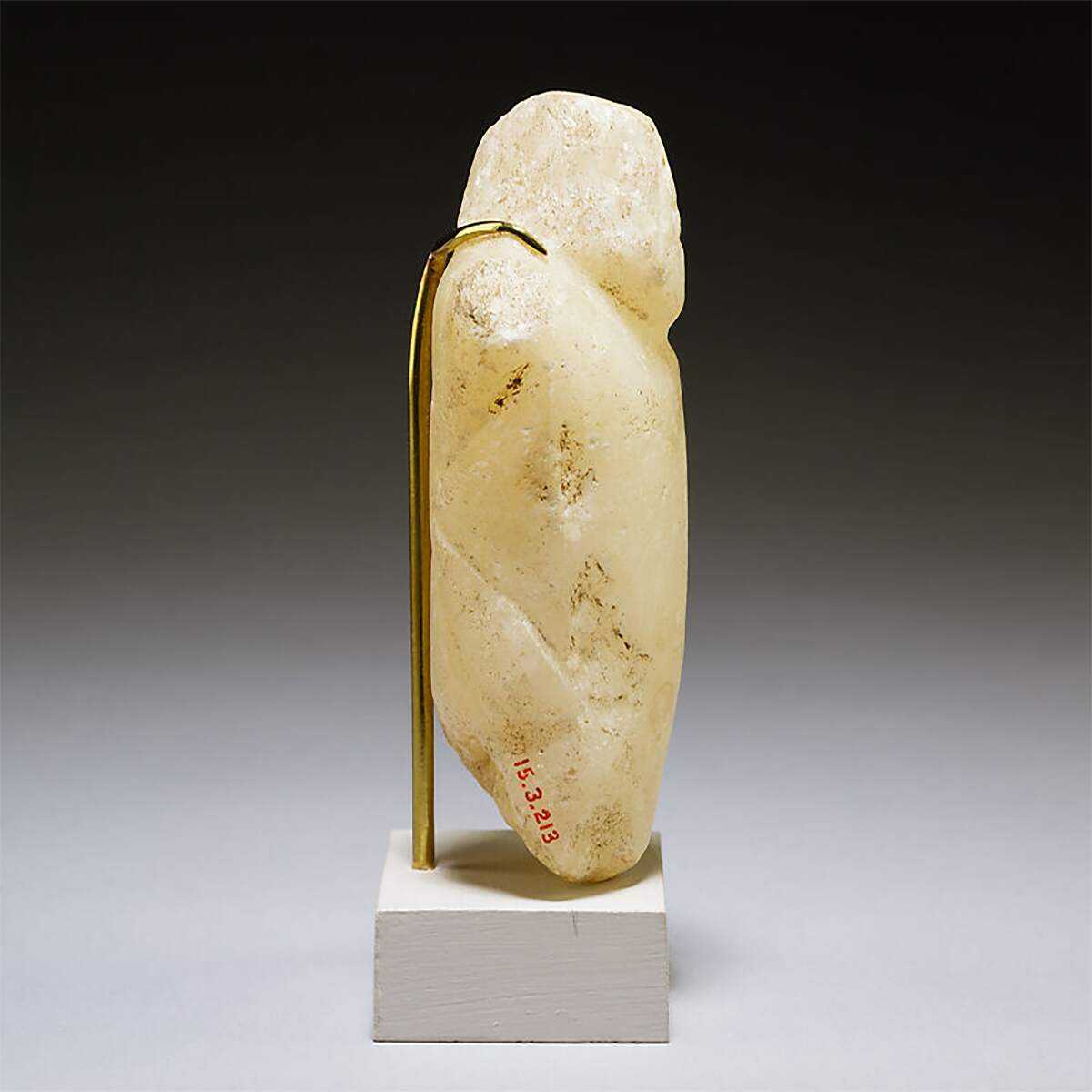
Magical Figure of Captive Middle Kingdom, Egypt 1981-1650 BC. Side view. Photo courtesy of the Met Museum.
Ancient Egyptian, Roman and Greek Witch Dolls
Jump ahead a few centuries, and you’ve got a temple in Roman Germany where someone stabbed a name-inscribed clay witch doll six times, twisted it, broke it, and buried it with burnt offerings (McKie, 70). Meanwhile, elsewhere in Rome, wax dolls with slivers of bone and hand-penned curses were sealed in lead boxes and dropped in cisterns, magical solitary confinement (Gordon, 165).
Many Roman curse dolls and tablets were found in Egypt, because Rome invaded Egypt. Then, after a lot of stabbing and dramatic exits, Rome officially claimed Egypt in 30 BCE. Prior, Octavian had gone toe-to-toe with Mark Antony. Meanwhile, the Battle of Actium in 31 BCE sealed Cleopatra’s fate.
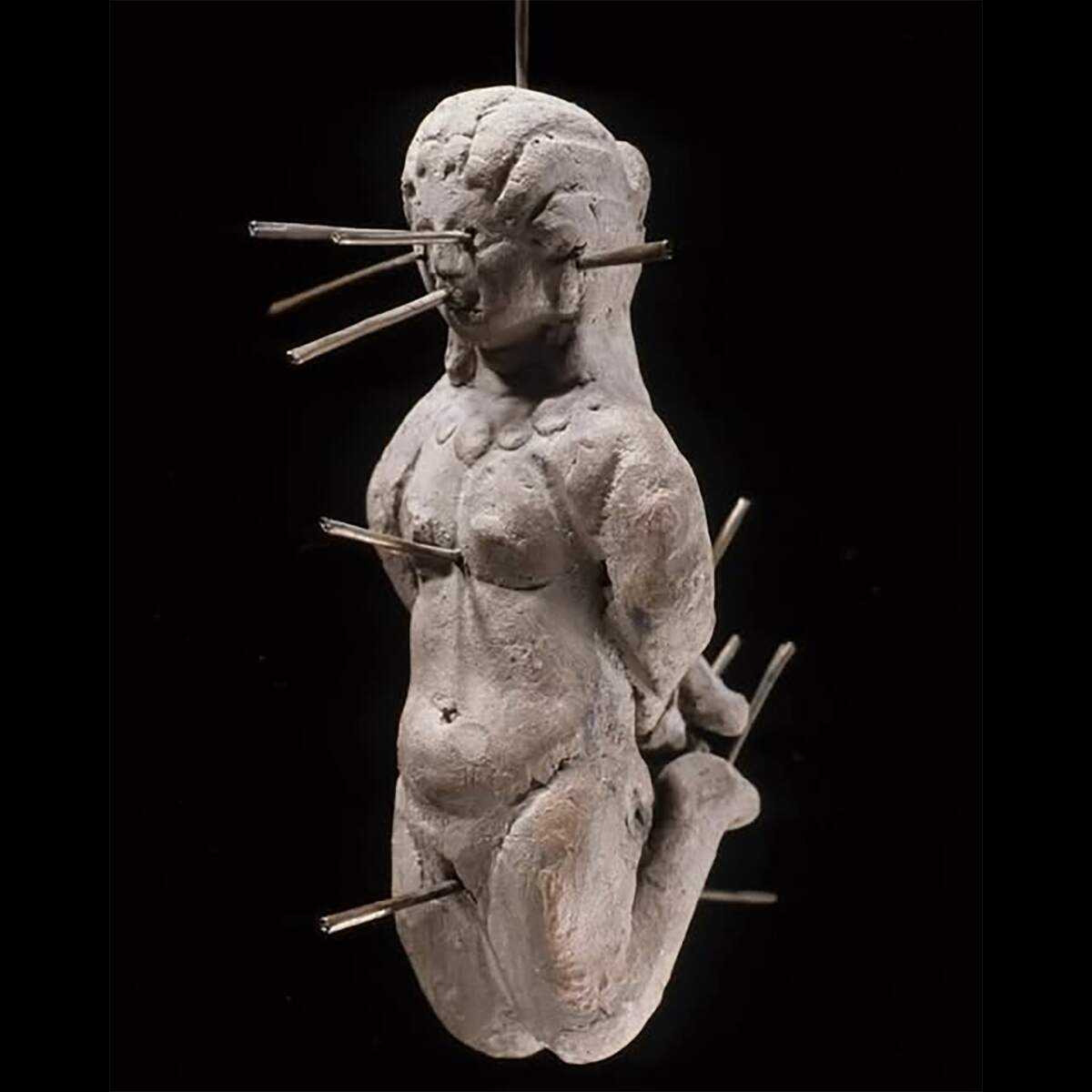
Roman curse doll of a nude female doll kneeling, bound and pierced with thirteen pins. Found in the Egyptian city of Antinoöpolis in terracotta vase with lead tablet binding spell (katadesmos). 3rd-4th centuries CE. Photo courtesy of Wikimedia Commons.
Afterward, Antony and Cleopatra both lost, and not just the battle. Finally, Octavian, soon to be Augustus, snagged Egypt for Rome. So, one power couple’s downfall became Rome’s victory. Thus, you find a lot of Roman and Greek witchcraft in Egypt.
The witch doll above was found in Antinoöpolis, an ancient Egyptian city in a terracotta vase along with a curse tablet with a binding spell.
Next, it gets juicy in Upper Egypt, 5th century CE. Specifically, two wax figures in an embrace were found in a cemetery pot with a papyrus spell. Understandably, it was love magic, of the coercive kind. Spoiler: it’s gross. Therefore, ethical PSA, just because some ancient wizard did it doesn’t mean you should. Consequently, ask yourself: Is this justice? Is it consent-based? Or are you just being a magical creep with witchcraft dolls?
Celtic Witch Dolls
In the meantime, medieval Ireland had its own take. For instance, poets would gather on hills, chant satirical curses, and stab clay kings with hawthorn thorns. Notably, the one-legged, one-eyed, one-armed ritual stance included. Importantly, Corrguinecht, the crane wounding posture, was believed to bridge the earthly and Otherworld realms (Ní Mhaoldomhnaigh, 15-16).
The Iron Age and early Christian era is host to many figurines and dolls, fashioned of iron, stone, wax and other materials. Some were of individuals, many preserved and used in multiple rituals.
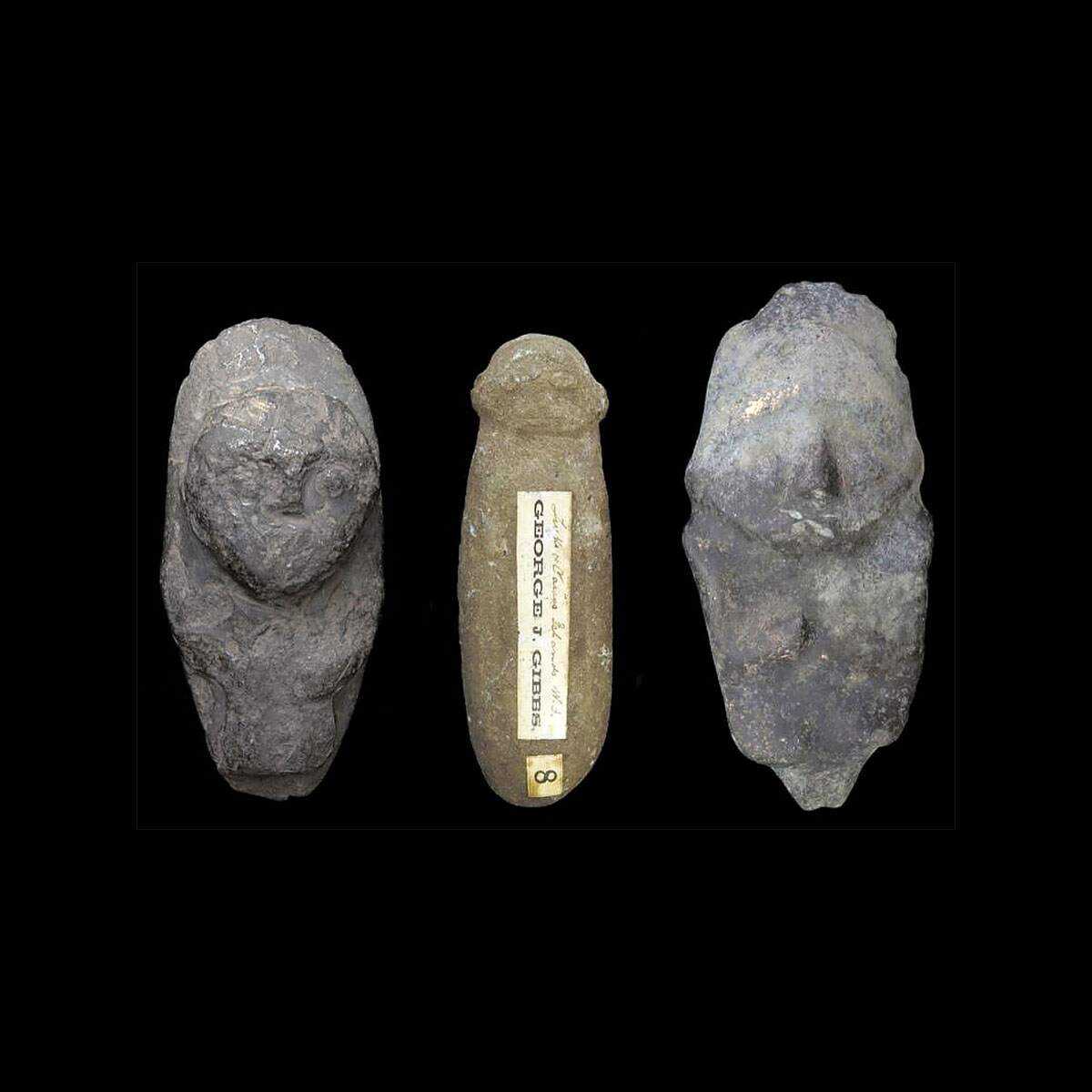
Set of small carved Caldragh figures from Boa Island, Ireland. Iron Age/Early Christian period. They represent ancient anthropomorphic deities and similar in craft to figures of individuals. They are dedicated to the public domain (University of Michigan Library CC0).
Then, fast forward again to 16th-century England and Scotland. Specifically, wax and hawthorn witchcraft dolls appear in witch trials. For example, Agnes Sampson famously conjured a yellow wax figure and melted it beside the fire to end a man’s life. Additionally, in the Scottish Highlands, when wax was scarce, they used clay. Or, y’know, a stuffed glove. Obviously, you work with what you’ve got (Wilby, 54; Black, 195).
I buy solid beeswax by the pound for doll-making and sometimes a pound of beeswax pellets. Great for candle making too.
From the 1,600’s to our current modern post-industrial era, witch dolls have evolved a lot, Different and finer materials and tools along with people’s love of creativity led to more artful and beautiful works. Below is a picture of some simple, but modern Celtic-style witch dolls, often referred to as poppets.
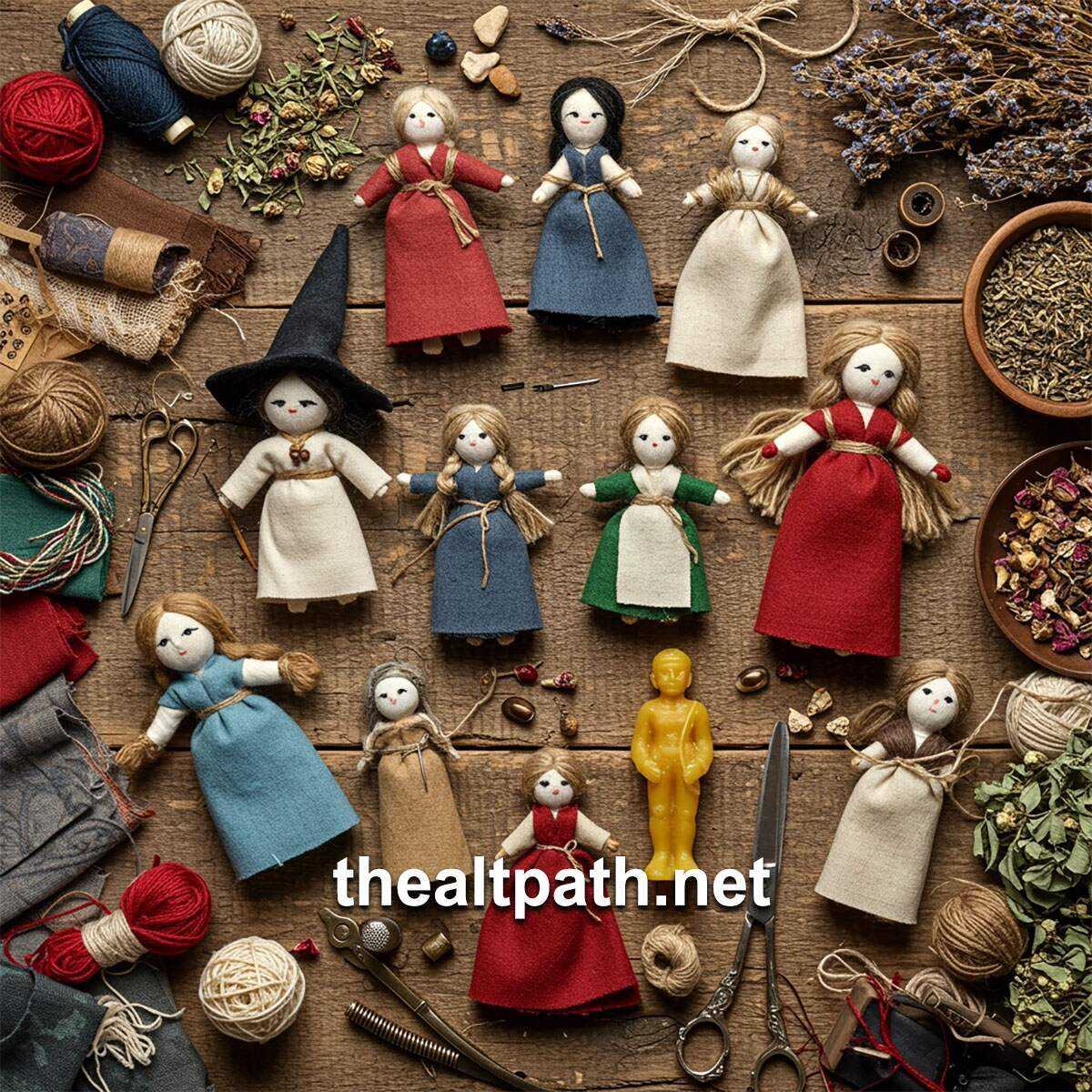
Modern era typical Celtic style witch dolls
African Clay and Mud Dolls
Moreover, African traditions have their own lineage of clay-based magical figures. Notably, the Bocio (or Bocine) of West Africa (below image, left), especially among the Fon people of Benin, are clay or carved figures used for protection, power, or retaliation. Often activated through sacrifice, inscriptions, and ritual, these figures are potent forms of image magic, and their structure can be elaborately layered with bindings, metal, or organic materials. Though distinct from poppets or witchcraft dolls in Western contexts, Bocio share that same core principle: the image stands in for the target.
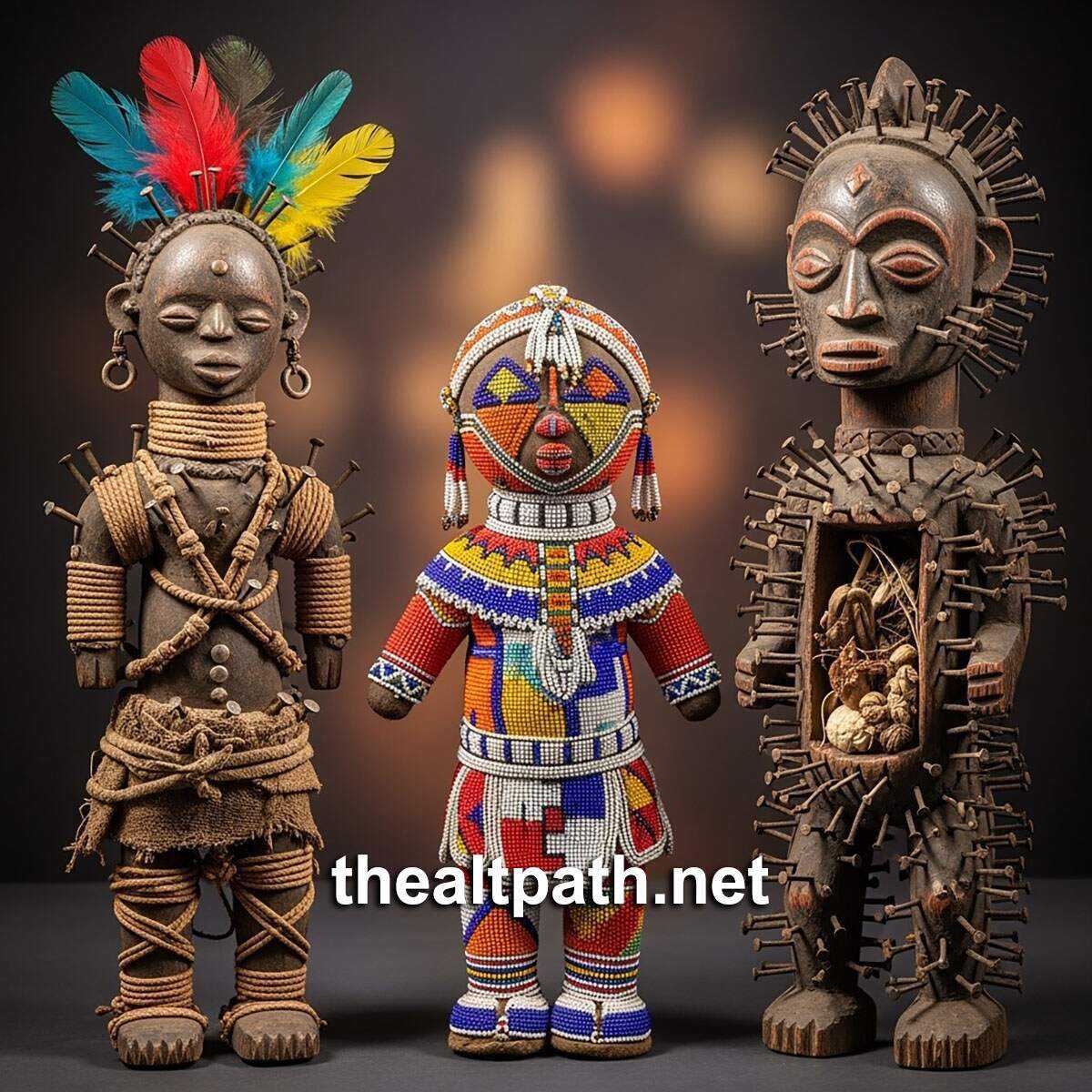
African Dolls Bocine, Zulu Healing Doll & Nkisi Nkondi
In Congo and surrounding areas (Central Africa), the nkondi, a type of nkisi, (above image far-right) is a spirit‑charged wooden or clay figure used in oath‑making, protection, and judicial magic. Pins or nails are driven into the figure to “awaken” the spirit or seal agreements, especially against wrongdoing.
The witch doll in the middle is a Zulu healing doll, highly decorative with and beaded. I think these are so beautiful. Beads symbolize various spiritual and emotional states. Often used for ancestral communication and healing rituals.
The doll on the far left is an African Bocio—also spelled boccio or bochio—a powerful, personalized wooden sculpture. These figures are created by the Fon people of Benin and nearby groups, especially within the Vodun (Voodoo) tradition.
These are just three of many examples of African image magic using dolls made of mud or clay. Furthermore, some were carved of wood and decorated for other purposes. Many African dolls are referred to as Fetish dolls, and some are meant to house powerful spirits that will rock your world if you mess with their maker.
Modern History and Effigies
Today, you’ll find witchcraft dolls crafted from everything from dough to builder’s putty. I’ve seen garlic heads with bird skulls or insects glued on, impressive commitment. The Museum of Witchcraft in Cornwall? A treasure trove of human creativity and revenge (https://museumofwitchcraftandmagic.co.uk/).
TIP: I even make “poppets” out of a lemon or a potato. A little carving and decorating and it absorbs whoever’s energy, or as it rots, the situation rots (sours or goes away). I can enchant them to absorb negative thinking or promote healing too.
But here’s the twist—witchcraft dolls aren’t all doom. Enter the harvest doll. From Slavic “Didukh” to the English Corn Dolly, and even Native American corn husk dolls, cultures around the world have long crafted figures from the first or last sheaves of harvest. These weren’t weapons but blessings, little vessels of fertility and protection, placed in shrines or homes for good luck.
Image magic doesn’t have to hurt. Votive offerings—figurines placed at sacred wells or shrines—date back to the Iron Age and still happen today. At Source des Roches in France, over 5,000 little figures were left in the waters, including body parts for healing and divine images for devotion (Hammersen, 53). Instead of binding someone with string, you’re blessing them using witchcraft dolls.
Some of my dolls get thorn-pierced, sure. But others get tiny armor. Some wear amulets. A few have cradles. They stand for protection, healing, grief, justice, whatever the work needs. In this way, figure magic remains vibrant, messy, and marvelously human. Some of my dolls belong in a Hellraiser sequel.
So, sculpting a clay doll or stitching a poppet for hexes or a healing wax doll for your altar, remember this: every witch doll holds power. That power comes responsibility. And at least a healthy respect for ancient weirdness.
Material to Make Clay for a Witch Doll
I could go on about creating fabric poppets, wax witch dolls and other forms, because clay and mud dolls are my faves, I’ll stick with those here.
Choose a good clay, the kind you have to bake to harden. The brand Sculpey works really well. Mix very fine earth from consecrated area from your property that you watered, strained and filtered until it’s very fine with Sculpey. The earth needs to be powder-like. About 1/4 earth to Sculpey clay ratio. Or make your own clay/mud entirely from scratch for a witch doll. Here’s what you’ll need:
- 1 quart or bigger mason jar, (enough for one good-size figurine).
- Enough earth to fill it at least 3/4’s of the way. Take out any big debris, rocks, plant matter etc.
- A large enough bowl to hold the “cleaned” earth.
- A fine mesh sieve for straining.
- A fine fabric cloth for second straining and large enough to tie around the finished ball of earth. You can use a handkerchief, I do. Mash bags work too!
Instructions for Making Clay for Witch Dolls
- Put the earth in the large bowl, flatten it out level. Pour on water, a little at a time, until the water stands just a little over the dirt. Let it sit for 15 minutes.
- Using your sieve, strain into your jar, this is your first straining. Leave it sit for 3-4 hours, and pour off all the extra water.
- Now, in your clean bowl, place the sieve with the fabric in it for a finer filter, dump your earth into it.
- Once it has drained, gather it up, tie it off or use a rubber band, squeeze it out and hang it up (watch out for drips!)
- Leave it hang for about 4 hours, squeeze it once in a while.
- Once it has stopped dripping, removed the fabric, ball it up and store in an air-tight container for up to about one year.
- It helps to make batches of these, so you always have some witch-clay on hand for your dolls.
Making the Doll – Tips and Techniques
To my mind, mandrake is a must in image magic whereas dolls are concerned. Do your homework, do some real research and you’ll know. It helps “bring life” to the doll. But it can be difficult work with. So, here are some tips to work mandrake into your clay dolls. I use a ton of dried, so I buy mandrake in bulk by the pound.
TIP: You have Podophyllum Peltatum, originating in America, used often by Native American Indians for their practices and also Mandragora officinarum, the European variety. I find both work equally as well.
- If you are using fresh mandrake, mince it up, dry it out in the sun or on warm in the oven, not all at once but in streaks, loosen it and turn it. Give it a rest in-between too. Now, you have made dried mandrake.
- Once you have made dried or bought dried mandrake, place in a mason jar, just cover with spirits like whiskey or bourbon. Let it soak overnight or even for a few days. Put in your food processer and turn this magical root into a very fine puree. Cover a large plate with paper towels, dump and spread the mandrake out. leave it sit for day or three until completely dry. It will now flake off and very easy to turn into fine powder using your mortar and pestle.
- Enchant the mandrake and work into your clay. Don’t know how? Learn how to enchant an item or ingredient. In fact, I invite you to explore all my articles to learn how witchcraft really works if you want to excel and become proficient.
- TIP: You can use whole mandrake for the body of a witch doll too.
What is Your Doll’s Purpose?

Gregory on clay dolls and image magic.
TIP: What is your doll for? You can work return to sender powder or hotfoot powder into your clay. If the doll is for your protection and you make one of yourself work black salt into it. Is it for prosperity or abundance? Try using cinquefoil (five-finger grass), goldenrod or mint! Get to know herb magic (wort cunning), because herbs work.
TIP: You need a heart and a tag-lock. You can choose a crystal for a heart, I often use a piece of copal resin. In some cases I use a chunk or a whole chicken liver.
A tag-lock is also called an “anchor” or “conduit”, this creates the astral and psychic connection to the target of the doll. If you don’t have hair, blood, nails etc. write the name down nine times backward on all natural paper, like from a brown paper bag. Think of nothing but that person while you do. Burn it, mix the ash into the clay before forming the figure.
TIP: Don’t forget to check and ensure there is no moon void of course phase while you are doing the work. Also, consider planetary days and hours, and what lunar cycle you want. In a pinch, Wednesday, provided there’s no void of course, are always good overall for most magic.
I am oath-bound as is every coven member, can’t tell you all my secrets now can I? But this is more than enough to get you started. Happy witching! Blessed Be.
References
Credits & References Gager, John G. Curse Tablets and Binding Spells from the Ancient World. Oxford University Press, 1999.
Gary, Gemma. Traditional Witchcraft: A Cornish Book of Ways. Troy Books, 2008.
Gordon, Richard. “Showing the Gods the Way: Curse-Tablets as Deictic Persuasion.” Religion in the Roman Empire 1, no. 2 (2015): 148.
Hammersen, Lauren. Indigenous Women in Gaul… Bangor University, 2017.
McKie, Stuart. “The Social Significance of Curse Tablets…” The Open University, 2017.
Museum of Witchcraft and Magic. https://museumofwitchcraftandmagic.co.uk/
Ní Mhaoldomhnaigh, Ailís. Satirical Narrative in Early Irish Literature. NUI Maynooth, 2007.
Ritner, Robert. The Mechanics of Ancient Egyptian Magical Practice. The Oriental Institute of the University of Chicago, 1993.
Tann, Mambo Chita. Haitian Vodou. Llewellyn Publications, 2012.
Wilby, Emma. Cunning-Folk and Familiar Spirits. Sussex Academic Press, 2006.
Black, Ronald. The Gaelic Otherworld. Birlinn, 2005.



Thank you again for the amazing article. It helped tremendously making my decision on which doll I will be choosing. I will be attempting making clay thank you for the ingredients.
You’re quite welcome Megan 🙂 like I said, clay dolls are my personal favorite. I think you’ll find making your own clay, from your own property and sacred soil very grounding, very satisfying and enjoyable. It’s good to have those extra batches on hand too, you never know when you’re going to need it. 🙂 Blessings!
I enjoyed learning about the different types of dolls. I look forward to making clay from scratch. Can I use earth from anywhere on my property? Is there any specific direction better than another? From what I understand is if your home is warded that land is all sacred. Is this correct? If not, how do I make an area sacred for using? Also, is Mandrake added before storing or at the time of crafting. Thank you so much!
Wow, what a great bunch of questions Erika! Love it. You can use earth from anywhere on your property, it is enchanted in the end is it not? However, I have just always felt it better when the area is consecrated and made sacred. This is done in so many ways in different cultures and traditions. Basically, aside from enchanting, you are dedicating the area, and starting with “treatments”. To consecrate ground in witchcraft, one typically creates a sacred space, sometimes casting a circle, and then various elements like blessed salt, water and incense and visualization to purify and dedicate the area for specific purposes. The process can vary, but often involves invoking the four cardinal directions and their associated elements (earth, air, fire, water) and energies to imbue the space with positive intent and power. See the ground accepting and absorbing that energy, raise your hands, use your power and authority voice and make declarations, like a powerful announcement that the land is consecrated, dedicated to nature (and/god(s) if you will. Use that area for witch-work, honor, beautify it, add to the soil …. just a few ways. And if your home is warded, I believe the ground around it is indeed “better” but I take the extra steps to consecrate the earth as well. You know me, I say enchant everything! 🙂 Lastly, you can make the Mandrake powder ahead of time. Blessings!
Correct me if I’m incorrect, but I can use Sculpey clay (i assume this is pre-made clay?), then corporate the dried mandrake into the clay. Then sculpt the figure. Is there an alternative way to break down the mandrake without using a food processor? I really like the idea of making a doll for purposes of positivity. I also like the option to use one for…Justice.
Hello Mary, great questions! Mixing Sculpey (yes-premade clay) with your fine earth (not made into clay) is a shortcut. And then yes, all the other desired powdered herbs, and mandrake are worked into it. A food processor is very convenient to break the mandrake down. I cut it into little pieces before soaking. Dried mandrake root is very tough! You can still soak, and then mash, then dry all by hand with mortar and pestle, but you are in for some serious work. And, if you go that route, I’ll tell you I end up doing this; soak, grind, back to soaking, grind, soak some more … grind. Ok, soak it again … just letting you know, it’s doable, and having a monster rough mortar and pestle, not some little cute thing, but like one made for an actual chef, and/or fine restaurant, a worthy one is definitely in order. 😉 Blessings! Oh, and you can make one doll for health, prosperity and protection (and add positivity to it too) or you can make separate ones, your choice. 🙂
I love this so very much. I only knew a few of these cultures dolls, now I am aware of many more. We will be making our dolls very soon. All of my questions have been answered💜🔮
Hello dear Luna, 🙂 I am thrilled you enjoyed this post and all your questions were answered. Yes, there are many types of witch-dolls, many more than what I covered too. I did want to provide a good sampling of witch dolls from around the world though. Dolls and effigies are such a huge part of image magic / sympathetic magic. 🙂 Blessings!
Thanks to your article I find myself interested in attempting to make a doll out of clay I process myself, but I wonder.
If I’m to attempt making one for healing purposes wouldn’t it be wise to avoid adding anything that may potentially rot within?
For example: using a rose quartz in place of a chicken liver for the heart? My concern over using raw meat is I would be giving this doll the breath of life and I worry that using raw meat in the doll would invite the potential of rot taking hold inside literally figuratively and emotionally within the doll as well as whomever the doll represents.
I could see the usefulness in banefull work but I would like to focus on healing at this point.
So for healing would it be best to avoid adding anything that could possibly cause inner rot?
Hell Cass, sorry for the slow reply. I use a piece of copal resin (which has always worked well), sometimes a crystal for certain properties like healing, rose quartz, golden healer etc. The only time I ever use a piece of chicken liver or anything that can rot is when that doll or poppet is a defensive one (to make their intentions “rot”, and if a poppet, often placed in a sour jar. I would never use anything that would rot when making an effigy of any type for yourself or a loved one. 🙂 Hope that clarifies for you. 🙂 Blessings.
I dont get why people are so obsessed with making these witch dolls from different cultures. Isnt it just cultural appropriation? Shouldnt we respect and honor these traditions instead of trying to profit off them?
Relax, its just art. Appreciating different cultures isnt always appropriation. Let creativity flow.